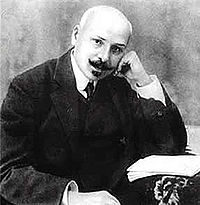Mykhailo Kotsiubynsky
| Mykhailo Mykhailovych Kotsiubynsky Михайло Михайлович Коцюбинський |
|
|---|---|
 |
|
| Born |
September 17, 1864 Vinnytsia, Russian Empire (now Ukraine) |
| Died | April 25, 1913 (aged 48) Kiev, Russian Empire (now Ukraine) |
| Pen name | Zakhar Kozub |
| Occupation | Writer |
| Nationality | Ukrainian |
| Spouse | Vira Ustymivna Kotsiubynska |
| Children | Yuriy, Oksana |
|
|
|
| Signature |  |
Mykhailo Mykhailovych Kotsiubynsky (Ukrainian: Михайло Михайлович Коцюбинський), (September 17, 1864 – April 25, 1913) was a Ukrainian author whose writings described typical Ukrainian life at the start of the 20th century. Kotsiubynsky's early stories were described as examples of ethnographic realism; in the years to come, with his style of writing becoming more and more sophisticated, he evolved into one of the most talented Ukrainian impressionist and modernist writers. The popularity of his novels later led to some of them being made into Soviet movies.
He grew up in Bar, Vinnytsia region and several other towns and villages in Podolia, where his father worked as a civil servant. He attended the Sharhorod Religious Boarding School from 1876 until 1880. He continued his studies at the Kamianets-Podilskyi Theological Seminary, but in 1882 he was expelled from the school for his political activities within the socialist movement. Already he had been influenced by the awakening Ukrainian national idea. His first attempts at writing prose in 1884 were also written in the Ukrainian language: Andriy Soloviyko(Ukrainian: Андрій Соловійко).
From 1888 to 1890, he was a member of the Vinnytsia Municipal Duma. In 1890, he visited Galicia, where he met several other Ukrainian cultural figures including Ivan Franko and Volodymyr Hnatiuk. It was there in Lviv that his first story Nasha Khatka (Ukrainian: Наша хатка) was published.
During this period, he worked as a private tutor in and near Vinnytsia. There, he could study life in traditional Ukrainian villages, which was something he often came back to in his stories including the 1891 Na Viru (Ukrainian: На віру) and the 1901 Dorohoiu tsinoiu (Ukrainian: Дорогою ціною).
...
Wikipedia
